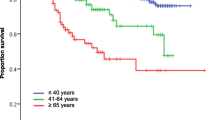Abstract
Background
We assessed volume changes after neoadjuvant chemotherapy and evaluated relations between tumor size changes and clinical characteristics. In addition, we sought to determine whether tumor size change influences patient outcome.
Methods
The records of 127 patients with stage II osteosarcoma who showed more than a 15% volume change after chemotherapy were retrospectively reviewed. Patients were divided into two groups depending on whether tumors increased or decreased in size. Fisher’s exact test was performed to analyze correlations between tumor size changes and clinicopathological variables. Five-year metastasis-free survival and overall survival were evaluated using univariate and multivariate analyses.
Results
A total of 71 patients (55.9%) showed a decrease in tumor volume, and 56 patients (44.1%) showed an increase. An increase in tumor volume after neoadjuvant chemotherapy was found to be positively correlated with a poor histological response and subsequent metastasis. Univariate analysis identified the following parameters as poor prognostic factors: age ≤15 years (P = 0.03), American Joint Committee on Cancer (AJCC) stage IIB (P = 0.02), a subtype other than osteoblastic (P < 0.01), a poor histological response (P < 0.001), and increased tumor volume after preoperative chemotherapy (P < 0.0001). Multivariate analysis revealed that AJCC stage IIB (P = 0.006) and an increase in tumor volume after preoperative chemotherapy (P < 0.001) both independently shortened metastasis-free survival. However, a poor histological response lost its prognostic significance (P = 0.34).
Conclusions
Increased tumor volume after neoadjuvant chemotherapy independently shortened metastasis-free and overall survival in AJCC stage II osteosarcoma patients. Tumor volume changes may serve as a basis for risk-adapted therapy when used in combination with other prognostic factors.
Similar content being viewed by others
References
Balu-Maestro C, Chapellier C, Bleuse A, Chanalet I, Chauvel C, Largillier R. Imaging in evaluation of response to neoadjuvant breast cancer treatment benefits of MRI. Breast Cancer Res Treat 2002;72:145–152.
Onikul E, Fletcher BD, Parham DM, Chen G. Accuracy of MR imaging for estimating intraosseous extent of osteosarcoma. AJR Am J Roentgenol 1996;167:1211–1215.
Therasse P, Arbuck SG, Eisenhauer EA, Wanders J, Kaplan RS, Rubinstein L, et al. New guidelines to evaluate the response to treatment in solid tumors: European Organization for Research and Treatment of Cancer, National Cancer Institute of the United States, National Cancer Institute of Canada. J Natl Cancer Inst 2000;92:205–216.
Holscher HC, Bloem JL, Vanel D, Hermans J, Nooy MA, Taminiau AH, et al. Osteosarcoma: chemotherapy-induced changes at MR imaging. Radiology 1992;182:839–844.
Lawrence JA, Babyn PS, Chan HS, Thorner PS, Pron GE, Krajbich IJ. Extremity osteosarcoma in childhood: prognostic value of radiologic imaging. Radiology 1993;189:43–47.
Picci P, Bacci G, Campanacci M, Gasparini M, Pilotti S, Cerasoli S, et al. Histologic evaluation of necrosis in osteosarcoma induced by chemotherapy. regional map** of viable and nonviable tumor. Cancer 1985;56:1515–1521.
Salzer-Kuntschik M, Delling G, Beron G, Sigmund R. Morphological grades of regression in osteosarcoma after polychemotherapy: study COSS 80. J Cancer Res Clin Oncol 1983; 106(suppl):21–24.
Shin KH, Moon SH, Suh JS, Yang WI. Tumor volume change as a predictor of chemotherapeutic response in osteosarcoma. Clin Orthop 2000;376:200–208.
Kim MS, Lee SY, Cho WH, Song WS, Koh JS, Lee JA, et al. Tumor necrosis rate adjusted by tumor volume change is a better predictor of survival of localized osteosarcoma patients. Ann Surg Oncol 2008;15:906–914.
Kim MS, Cho WH, Song WS, Lee SY, Jeon DG. Time dependency of prognostic factors in patients with stage II osteosarcomas. Clin Orthop 2007;463:157–165.
Rosen G, Marcove RC, Huvos AG, Caparros BI, Lane JM, Nirenberg A, et al. Primary osteogenic sarcoma: eight-year experience with adjuvant chemotherapy. J Cancer Res Clin Oncol 1983;106(suppl):55–67.
Bieling P, Rehan N, Winkler P, Helmke K, Maas R, Fuchs N, et al. Tumor size and prognosis in aggressively treated osteosarcoma. J Clin Oncol 1996;14:848–858.
Bielack SS, Kempf-Bielack B, Delling G, Exner GU, Flege S, Helmke K, et al. Prognostic factors in high-grade osteosarcoma of the extremities or trunk: an analysis of 1,702 patients treated on Neoadjuvant Cooperative Osteosarcoma study group protocols. J Clin Oncol 2002;20:776–790.
Taylor WF, Ivins JC, Unni KK, Beabout JW, Golenzer HJ, Black LE. Prognostic variables in osteosarcoma: a multi-institutional study. J Natl Cancer Inst 1989;81:21–30.
Moon SH, Shin KH, Suh JS, Yang WI, Noh JK, Hahn SB. Tumor volume change after chemotheraphy as a predictive factor of disease free survival for osteosarcoma. Yonsei Med J 2005;46:119–124.
Holscher HC, Bloem JL, van der Woude HJ, Hermans J, Nooy MA, Taminiau AH, et al. Can MRI predict the histopathological response in patients with osteosarcoma after the first cycle of chemotherapy? Clin Radiol 1995;50:384–390.
Van der Woude HJ, Bloem JL, Hogendoorn PC. Preoperative evaluation and monitoring chemotherapy in patients with high-grade osteogenic and Ewing’s sarcoma: review of current imaging modalities. Skeletal Radiol 1998;27:57–71.
Bacci G, Longhi A, Fagioli F, Briccoli A, Versari M, Picci P. Adjuvant and neoadjuvant chemotherapy for osteosarcoma of the extremities: 27 year experience at Rizzoli Institute, Italy. Eur J Cancer 2005;41:2836–2845.
Davis AM, Bell RS, Goodwin PJ. Prognostic factors in osteosarcoma: a critical review. J Clin Oncol 1994;12:423–431.
Glasser DB, Lane JM, Huvos AG, Marcove RC, Rosen G. Survival, prognosis, and therapeutic response in osteogenic sarcoma: the Memorial Hospital experience. Cancer 1992;69:698–708.
Mankin HJ, Hornicek FJ, Rosenberg AE, Harmon DC, Gebhardt MC. Survival data for 648 patients with osteosarcoma treated at one institution. Clin Orthop 2004;429:286–291.
Author information
Authors and Affiliations
About this article
Cite this article
Kim, M.S., Lee, SY., Cho, W.H. et al. Effect of increases in tumor volume after neoadjuvant chemotherapy on the outcome of stage II osteosarcoma regardless of histological response. J Orthop Sci 14, 292–297 (2009). https://doi.org/10.1007/s00776-009-1334-y
Received:
Accepted:
Published:
Issue Date:
DOI: https://doi.org/10.1007/s00776-009-1334-y




